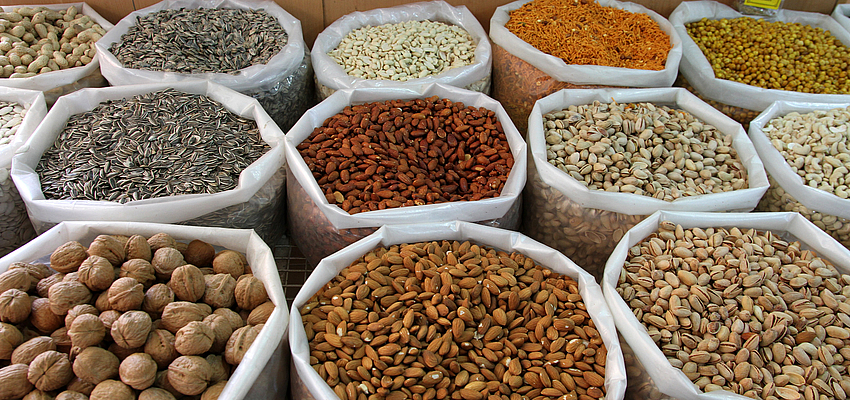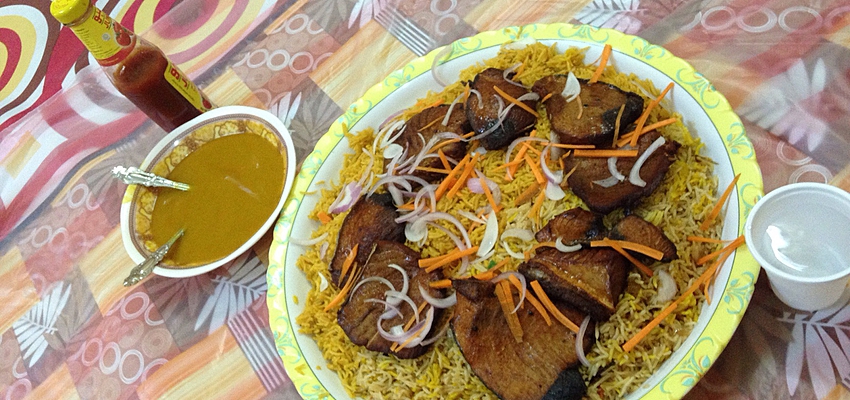


The Sultanate of Oman, the land of convergence, offers a gastronomy rich in multiple influences.
Traditional Omani cuisine revolves around two main dishes: shuwa and biryani rice. Shuwa is lamb cooked in a pit over fire for two days and is served for the Eid festival, at the end of Ramadan, and one lunar month after Ramadan. It's an opportunity for the family to come together and eat, while seated on cushions. It can be summed up in a single word: sharing, because there are no plates; each person serves themselves from large, overflowing trays placed in the middle of the circle.
Biryani rice, infused with saffron, is served on a large platter. It can be made with beef, lamb, chicken or even fish (often tuna), which is roasted on the fire. The rice is flavoured with a tomato, onion and pepper based sauce. It's all eaten with a small raw vegetable salad. There is a barbecue alternative: chicken or lamb skewers are marinated in yoghurt and spices and then grilled. Biryani rice is eaten at outdoor family picnics, on a mat unrolled on the ground. You can also find it in coffee shops, little cafes situated next to every mosque, service stations, or along the roads… These restaurants offer small, private areas, and you can either treat yourselves by sitting on the yellow-orange rug, or choose the take-away option.

Omanis drink cola or Mountain Dew, a sort of green, chemical soft drink, as a beverage... They are also fond of freshly squeezed juices… and it's not just ordinary orange juice here! 'Lemon-mint', mango or pineapple... a real treat! A little hookah with your juice, and you'll be getting the full experience of the country's little pleasures.
Alcohol is prohibited, so expats can find it in hotel bars that have the licence. And it is still common to bump into locals wearing a dishdasha, the traditional dress worn by Omanis and comparable to our dinner jackets, but the issue remains taboo and may be associated with prostitution.
Let's talk a little about influences. Oman is a very cosmopolitan country, and Omani cuisine has strongly been transformed by it. India and Pakistan were the first sources of inspiration...and you surely know biryani rice from them! The massive emigration of people from India and Pakistan, mainly for work in construction, has had an impact on eating habits. In the farthest reaches of the desert, it just takes a motorway being built to help restaurants flourish.
Sri Lanka and even Zanzibar, a former Omani colony, have also made their mark. Many Asians, mainly Thai and Malaysian, who have arrived more recently, have also brought their cuisine with them. For a foodie in Muscat, Turkish and Lebanese restaurants are trendy.
The European influence can be seen with certain brands that have been successful crossing borders, like Carillion's construction services. English concepts like 'Darcy's Kitchen' and 'Shakespeare,' with their cutesy girl décor, are increasingly present in the malls in Oman and Dubai. Junk food has also made its arrival with some well-known fast-food chains, and it has caused some obesity problems, particularly among women. All types of appetites can be satisfied in the malls - burgers, pizza, grilled chicken, Chinese food, ice cream, and American-style cakes filled with cream...
In the Sultanate of Oman, the way of life is largely based on the weather and temperature... It rises so high that staying outside is really not an option. That's one of the reasons why air conditioned malls and restaurants there are so successful! When nice weather returns in the winter and it's 27 degrees at most, barbecues are very popular, with family or friends, on the beach, in green parks or wadis, where streams mark a fertile area in the middle of the desert and people can sit next to the water. And the barbecue aisle in the supermarket is well-stocked! You can find equipment that would startle any camping enthusiast from chairs to coolers and Bedouin tents, which are plastic today but used to be made of red-and-black striped heavy wool.